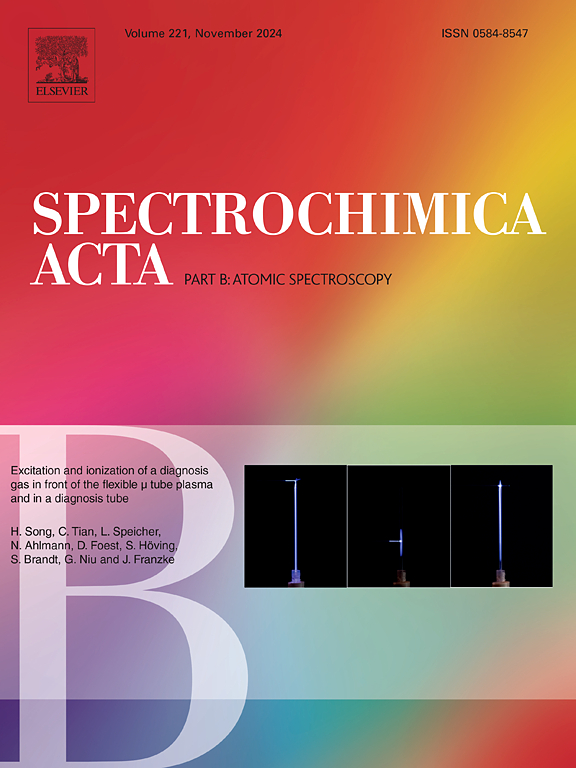Development of inductively coupled plasma tandem mass spectrometric method for the determination of cadmium in tumorous stem mustard (Brassica juncea var. tumida Tsen et Lee) using N2O as reaction gas
IF 3.2
2区 化学
Q1 SPECTROSCOPY
引用次数: 0
Abstract
This work proposed a novel method to determine trace levels of Cd in tumorous stem mustard (TSM) using inductively coupled plasma tandem mass spectrometry (ICP-MS/MS). In the MS/MS mode, N2O was used as a reaction gas to eliminate spectral interference and optimize the analysis conditions. The accuracy and precision of the proposed method were evaluated by analysis of spinach leaves (SRM 1570a) as standard reference material and by comparing the obtained results with those achieved using sector field ICP-MS (SF-ICP-MS). The limit of detection (LOD) of Cd was in the range of 0.83–5.64 ng L−1, and the LOD of 114Cd with the highest sensitivity was as low as 1.28 ng L−1. At a 95 % confidence level, no significant differences were found between the results obtained via this method and SF-ICP-MS (p > 0.05), with relative standard deviation (RSD) of 1.4 %–2.5 %. The experimental results indicate that the developed method exhibits high sensitivity, accuracy, and reliability, making it suitable for interference-free detection of trace Cd in TSM.

以N2O为反应气体电感耦合等离子体串联质谱法测定肿瘤芥菜(Brassica juncea var. tumida Tsen et Lee)中镉
本文提出了一种利用电感耦合等离子体串联质谱(ICP-MS/MS)测定肿瘤芥菜(TSM)中痕量Cd水平的新方法。在MS/MS模式下,以N2O为反应气体,消除光谱干扰,优化分析条件。以菠菜叶片(SRM 1570a)为标准参比物,并与扇形场ICP-MS (SF-ICP-MS)测定结果进行比较,评价了该方法的准确度和精密度。Cd的检出限(LOD)在0.83 ~ 5.64 ng L−1之间,其中灵敏度最高的114Cd的LOD低至1.28 ng L−1。在95%的置信水平上,通过该方法获得的结果与SF-ICP-MS (p >;0.05),相对标准偏差(RSD)为1.4% ~ 2.5%。实验结果表明,该方法具有较高的灵敏度、准确性和可靠性,适用于TSM中痕量Cd的无干扰检测。
本文章由计算机程序翻译,如有差异,请以英文原文为准。
求助全文
约1分钟内获得全文
求助全文
来源期刊
CiteScore
6.10
自引率
12.10%
发文量
173
审稿时长
81 days
期刊介绍:
Spectrochimica Acta Part B: Atomic Spectroscopy, is intended for the rapid publication of both original work and reviews in the following fields:
Atomic Emission (AES), Atomic Absorption (AAS) and Atomic Fluorescence (AFS) spectroscopy;
Mass Spectrometry (MS) for inorganic analysis covering Spark Source (SS-MS), Inductively Coupled Plasma (ICP-MS), Glow Discharge (GD-MS), and Secondary Ion Mass Spectrometry (SIMS).
Laser induced atomic spectroscopy for inorganic analysis, including non-linear optical laser spectroscopy, covering Laser Enhanced Ionization (LEI), Laser Induced Fluorescence (LIF), Resonance Ionization Spectroscopy (RIS) and Resonance Ionization Mass Spectrometry (RIMS); Laser Induced Breakdown Spectroscopy (LIBS); Cavity Ringdown Spectroscopy (CRDS), Laser Ablation Inductively Coupled Plasma Atomic Emission Spectroscopy (LA-ICP-AES) and Laser Ablation Inductively Coupled Plasma Mass Spectrometry (LA-ICP-MS).
X-ray spectrometry, X-ray Optics and Microanalysis, including X-ray fluorescence spectrometry (XRF) and related techniques, in particular Total-reflection X-ray Fluorescence Spectrometry (TXRF), and Synchrotron Radiation-excited Total reflection XRF (SR-TXRF).
Manuscripts dealing with (i) fundamentals, (ii) methodology development, (iii)instrumentation, and (iv) applications, can be submitted for publication.

 求助内容:
求助内容: 应助结果提醒方式:
应助结果提醒方式:


